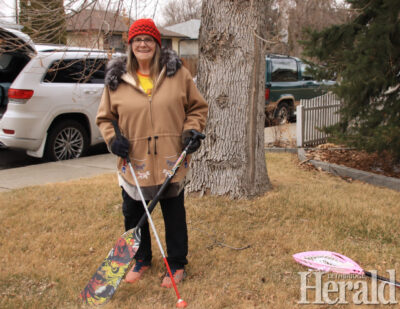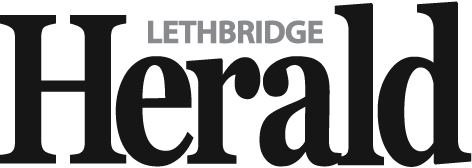Emily Lawson doesn’t let being legally blind keep her from doing what she loves
By Lethbridge Herald on April 2, 2025.
 Emily Larson stands with her cane and dragon boat paddle alongside her lacrosse stick, which she actively participates in both activities even while being legally blind.
Herald photo by Alexandra Noad
Emily Larson stands with her cane and dragon boat paddle alongside her lacrosse stick, which she actively participates in both activities even while being legally blind.
Herald photo by Alexandra NoadALEXANDRA NOAD – Local Journalism Initiative Reporter
A Lethbridge woman who moved from Northwest Territories after losing her sight hasn’t let her loss of vision affect her positive outlook on life.
Emily Lawson was born with a degenerative eye disease and was treated for many years through injections to her eyes. The treatments weren’t offered in her hometown of Yellowknife, so she had to fly to Edmonton for thm.
When COVID-19 hit, she had to stop flying and after a few months, the treatment was made available in Yellowknife. But an unfortunate incident caused Lawson to need major surgery in Edmonton. Miraculously, while the Royal Alexander Hospital had 136 Covid cases in the ICU, Lawson didn’t catch it. Unfortunately, due to the incident, Lawson’s option to return home to Yellowknife was out of the question as she needed further surgery and had a long road of recovery ahead of her. When given the choice between moving to Edmonton, Calgary or Lethbridge to continue treatment, she chose Lethbridge, as her son lived here while attending university.
After a seven-month recovery period, Lawson found herself in Edmonton again for an ultrasound and pre-op checkup. Then one day in the fall of 2021, she got the call to be in Edmonton within 12 hours for her operation. Another miracle happened as it was the first night WestJet flew out of Lethbridge. While the surgery was not the most comfortable experience and required another two years of treatment and careful monitoring, Lawson says she’s is extremely grateful for the care she has received.
“I went from not seeing much, other than ghostly lines, to now being low vision,” she says. “I am legally blind, but I’m certainly far more functional.”
As she is also an artist, she remembers the day she saw colour again and felt like jumping for joy. But being legally blind and navigating a new city was a whole other challenge for Lawson.
“It’s been five years of hard work learning how to navigate,” says Lawson. Walking on a sidewalk, not getting lost, using an OrCam (a reading device for the visually impaired) because she can’t read street signs, and learning how to use the bus were all challenges Lawson faced on a daily basis.
She adds while the Lethbridge Blind Association has been a great help to her, Lethbridge does not have a Canadian National Institute for the Blind (CNIB) chapter in Lethbridge, so in order to get tools and supports from CNIB, she has had to travel to Calgary or Edmonton.
On top of the added travel expenses, Lawson says many items are only partially funded, which means the rest has to come out of her already limited funds.
“Some of the specialty items are partially funded, however, that partially funded means out of our pension comes the other portion. So I am carrying debt and coping, but it hasn’t been an easy journey.”
She has also had to learn an entirely different computer operating system, as one of her accessibilty programs was only available on PCs and so she made the switchover from a Mac.
Another tool she has found is “Be My Eyes,” an app which helps visually impaired people with basic tasks such as finding her birth certificate on a carpeted floor. Lawson says without tools such as this, things that sighted people take for granted, are nearly impossible for the visually impaired.
“We found the birth certificate in like two-and-a-half-minutes and I had been on the floor looking for an hour,” she says.
Lawson is currently looking into getting a guide dog, however due to the pandemic, most programs suspended their breeding programs, so an already long waitlist is even longer.
She adds that she has been actively calling to get on a waitlist for the last five years, but has yet to find one accepting new applicants.
She considers having a guide dog to be preventative health measure, as she’s already fallen off the sidewalk a couple of times. The last one left her in the hospital. Having a dog would not only prevent injuries, but it would also help her preserve her active lifestyle with the dream of running – yes, running – a 2k race.
“We did our first Sight Night Walk in the fall,” says Lawson, who is active in a number of sports. “so for me, I would dream of being able to run that 2k. At this point I can’t run; it’s just too dangerous, so a dog and an escort holding my elbow or hand means I’ll be able to run again.”
She has already committed $1,000 of her savings towards a service dog, but she still has $20,000 to go to buy her service dog. Lawson currently has a gofundme to help with the financial barrier of getting a service dog, which can be accessed through her Facebook page, Emily Avoiding Blindspots Lawson.
While there are things Lawson knows she will never be able to do, she won’t let the lack of sight stop her from trying new things and looking for new ways of trying the things she used to love doing.
“I will never drive a car again because of the incident and I have moments of not really feeling happy about that, but I’m really happy I can paddle my canoe, I am really happy I can be on a dragon boat team and super happy that I can walk two kilometres.”
22-21


